Reconviction rates in Scotland: 2013-2014 offender cohort
Scottish Government publication providing analysis of trends in reconviction figures up to the latest cohort of 2013 to 2014.
This document is part of a collection
1. Main findings: reconviction rates for court disposals
1.1 Headline figures
( Table 1 )
There were 42,193 offenders discharged from custody or given a non-custodial sentence in 2013-14, a number which has generally been declining every year from 53,327 in 2006-07 but has increased by 1.1 per cent (478 offenders) from 41,715 in 2012-13.
The reconviction rate and average number of reconvictions per offender ( Table 1 and Chart 1) have generally been declining over the past decade. There was a slight increase in both the reconviction rate and average number of reconvictions per offender in 2008-09 which is likely to be due to the Summary Justice Reforms (see Annex E in the Criminal Proceedings in Scotland publication) which meant that cases were processed faster through the courts. Between 2004-05 and 2013-14, the reconviction rate has fallen by 4.1 percentage points from 32.4 to 28.3, and the average number of reconvictions per offender has fallen by 16 per cent from 0.61 to 0.51. These reductions are set against the context of a falling number of crimes recorded by the police since 2004-05 ( Recorded Crime in Scotland, 2014-15). Crime and victimisation surveys also reveal a similar pattern of falling incidence of crime ( Scottish Crime and Justice Survey, 2014-15).
1.2 Age and gender
( Table 2 , Table 3 , Table 4 and Table 5)
Headlines for gender
Continuing a persistent long-term trend, males have higher reconviction rates and a higher average number of reconvictions per offender than females ( Table 2). The average number of reconvictions per offender for the 2013-14 cohort was 0.53 for males, and 0.43 for females which represents a 2 and 4 per cent decrease since 2012-13 respectively. The reconviction rates were 29.4 per cent for males and 22.9 per cent for females, representing a 0.6 and 1.0 percentage point decrease since 2012-13 respectively.
Aged under 21 [2]
Offenders under the age of 21 had the highest reconviction rate of all the age groups (34.1 per cent) in 2013-14, as well as the highest average number of reconvictions per offender (0.61). This was 7 per cent higher than for the age group with the second highest average number of reconvictions per offender, which was the 31 to 40 age category at 0.57 ( Table 3).
Whilst reconvictions for offenders aged under 21 used to be considerably higher than the other age groups, they have showed substantial declines over time to their current levels which are now more similar to the other age groups. In 1997-98 the difference between the under 21 age group and the next highest group, 21-25 age group, for the average reconvictions per offender was 0.3 whereas in the most recent cohort the difference with the next highest age group, 31 to 40, is 0.04 ( Chart 3).
Males aged under 21 had the highest reconviction rate (35.7 per cent) and average number of reconvictions per offender (0.63) of any age-gender combination in 2013-14. The average number of reconvictions per offender was only slightly higher than that for males aged 31 to 40, who had an average of 0.59 reconvictions per offender in the same year ( Table 4 and Chart 3).
The average number of reconvictions per offender has decreased by 34 per cent from its highest level of 0.93 in 1997-98 to 0.61 in 2013-14. The reconviction rate of the under 21 age group has increased for the first time since 2005-06, rising by nearly 1 percentage point from 33.4 in 2012-13 to 34.1 in 2013-14. Despite the recent increase the current value is still 5.3 percentage points lower than 39.4 per cent in 2004-05 and 8.3 percentage points lower than the 1997-98 value of 42.4 ( Table 3).
Aged between 21 to 25
There has also been a long-term decline in the reconviction rate and average number of reconvictions per offender in the 21 to 25 age group in the past ten years. The reconviction rate decreased by 7.2 percentage points from 36.5 per cent in 2004-5 to 29.3 per cent in 2013-14; and in the same period the average number of reconvictions per offender decreased from 0.71 to 0.50, a 30 per cent reduction ( Table 3).
Aged between 26 and 30
Unlike the younger age group, the figures for the 26 to 30 year age group have shown no clear trend in the past ten years ( Table 3). Between 2004-05 and 2011-12 the average number of reconvictions per offender fluctuated between 0.62 and 0.68 and in 2013-14 dropped to the lowest value in the last ten years, 0.56, representing a 5 per cent decrease since 2012-13 and the second consecutive year on year decrease. The reconviction rate for this age group has also decreased since 2012-13 to a ten year low value of 31 per cent, a decrease of 0.4 percentage points since 2012-13.
Aged over 30
Reconvictions of the older age groups have generally increased over the past ten years. Between 2004-05 and 2013-14, the reconviction rate for offenders aged 31 to 40 and those aged over 40 both increased by 1.3 percentage points, from 28.9 per cent to 30.2 per cent, and from 19.2 to 20.5 respectively. In the same time period, the average number of reconvictions per offender for the 31 to 40 age group has increased by 14 per cent from 0.50 to 0.57, and for the over 40 age group, it has increased by nearly 16 per cent from 0.32 to 0.37. In contrast to the longer term increase, the reconviction rate is unchanged since 2012-13 while the average number of reconvictions per offender for the 31 to 40 age group have shown a slight decline in the past year. The reconviction rate and average number of reconvictions per offender for the over 40 age group are still considerably lower than for the other age groups ( Table 3).
Males
Patterns of change in reconvictions (both rates and averages numbers) for males of different age groups were generally the same ( Table 4) as those for all offenders ( Table 3), with males comprising the majority of offenders (83 per cent in 2013-14).
Since 2004-05 the average number of reconvictions per offender have decreased for males under 21 by 24 per cent (from 0.83 in 2004-05 to 0.63 in 2013-14) and for males aged 21 to 25 by 28 per cent (from 0.71 in 2004-05 to 0.51 in 2013-14). The average number of reconvictions per offender for males aged 26 to 30 have followed no clear trend over the past ten years. The average number of reconvictions per offender have increased for the older age groups. Males aged 31 to 40 have increased by nearly 16 per cent (from 0.51 in 2004-05 to 0.59 in 2013-14) and males aged over 40 years have increased by 15 per cent (from 0.33 in 2004-05 to 0.38 in 2013-14) ( Table 4 and Chart 3).
Females
Reconvictions for females aged under 21 and aged between 21 to 25 have decreased over the past ten years. The average number of reconvictions per offender decreased by nearly 26 per cent for females aged under 21 (from 0.58 in 2004-05 to 0.43 in 2013-14) and by around 39 per cent (from 0.69 in 2004-05 to 0.42 in 2013-14) for females age 21 to 25. Reconvictions for females aged 26 to 30 have been fluctuating over the past ten years. Reconvictions for females aged 31 to 40, and females over 40, have generally remained level over the past ten years ( Table 5 and Chart 4).
Contrasting males and females
Males and females differ in the age group with the highest levels of reconvictions. In 2013-14, females aged 26-30 had the highest average number of reconvictions per offender (0.53) of all female age groups whereas in males this age group is the third highest. For males the under 21 age group had the highest average number of reconvictions per offender (0.63) whereas in females this age group is the third highest. In both females and males, the over 40 age group had the lowest average number of reconvictions per offender of all age groups with values of 0.32 and 0.38 respectively ( Table 5 and Chart 4).
Chart 3: Average number of reconvictions per offender, males by age: 1997-98 to 2013-14 cohorts
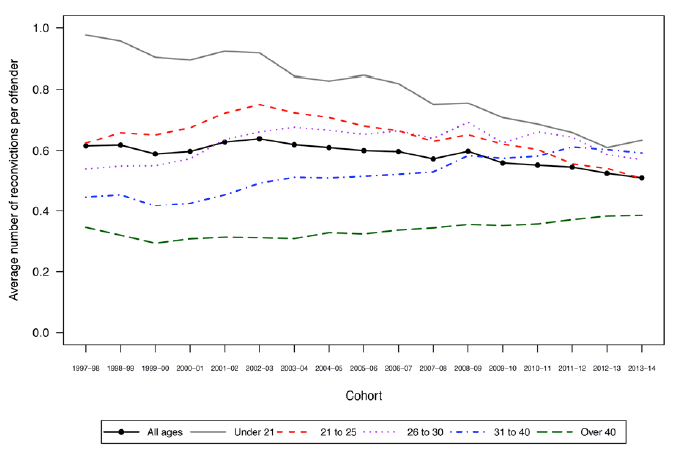
Chart 4: Average number of reconvictions per offender, females by age: 1997-98 to 2013-14 cohorts
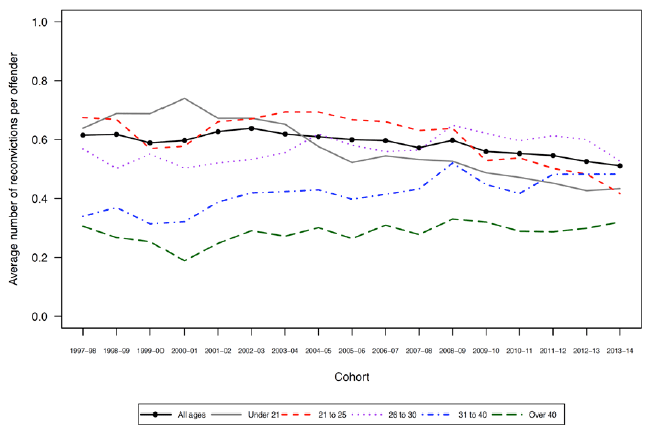
1.3 Index crime
An "index crime" is the crime which resulted in an "index conviction". This means it is the crime relating to the earliest conviction within a financial year of either:
(a) the estimated release date for a custodial sentence imposed for the conviction, or
(b) the sentence date for non-custodial sentences imposed for the conviction.
Whichever conviction has the earliest of these dates in a given financial year is defined as the index conviction (see Annex Table A1 and Annex A5 for definitions).
In general the data shows that offenders who were convicted for lower level index crimes (i.e. shoplifting), which tend to be committed in higher volumes, are more likely to be reconvicted than those who commit more serious crimes (i.e. sexual crimes). As has been true since 1997-98, offenders with an index crime of dishonesty, e.g. shoplifting (see Annex Table A2 for crime groupings), have the highest average number of reconvictions per offender and reconviction rate of any index crimes ( Table 6 and Chart 5). For the 2013-14 cohort, the average number of reconvictions per offender for offenders who were convicted of crimes of dishonesty was 0.94, and the reconviction rate was 41.3 per cent.
By index crime: sexual crimes
Offenders in the 2013-14 cohort who had an index crime of a sexual crime had the lowest average number of reconvictions per offender (0.15) and the lowest reconviction rate (10.3 per cent) of any index crime ( Chart 5 and Table 6). The reconviction rates and average number of reconvictions per offender for an index sexual crime are both lower in 2013-14 than they were in 2012-13, continuing a decline in both measures of reconvictions that followed an increase between 2009-10 and 2011-12. This earlier rise in part reflects an increased level of reporting in the wake of high profile cases. However, this is set against an increase of 24 per cent in the number of offenders (from 574 to 709) since 2004-05. Also, as these averages are based on small numbers of offenders, compared with other index crimes, caution should be taken in drawing any longer term conclusions as small underlying numbers are sensitive to large fluctuations in percentage change.
Other index crimes
Offenders from the 2013-14 cohort who had index crimes other than sexual crimes or crimes of dishonesty had an average number of reconvictions per offender between 0.33 and 0.55. The reconviction rates were between 21.9 and 31.3 per cent. The average number of reconvictions per offender for all index crimes has decreased since 2012-13 with the exception of criminal damage and dishonesty which increased by 7.8 per cent (from 0.51 to 0.55) and 1.1 per cent (from 0.93 to 0.94) respectively ( Table 6 and Chart 5).
Reconviction crime by index crime
Table 7 [3] shows the types of crimes that offenders in the 2013-14 cohort were reconvicted for, by the index crime. Overall, more offenders were reconvicted for breach of the peace than any other type of crime (10.3 per cent of all offenders), and fewer offenders were reconvicted for a sexual crime than any other type of crime (0.3 per cent of all offenders).
Table 7 also shows that for those offenders with index crimes of crimes of dishonesty, drug offences, or breach of the peace; the majority of those reconvicted were for the same type of crime as their index crime. However, for those convicted of violent crimes, criminal damage, or other crimes, the majority of those reconvicted were for breach of the peace. Similarly, for those convicted of sexual crimes, the majority of those reconvicted were for other crimes or offences. It is important to note that even index crimes where the majority of those offenders reconvicted were for the same crime as the index crime, there were some offenders who were reconvicted for different crimes to their index crimes. This suggests that offenders don't necessarily specialise in a particular type of crime.
Chart 5: Average number of reconvictions per offender, by index crime: 1997-98 to 2013-14 cohorts
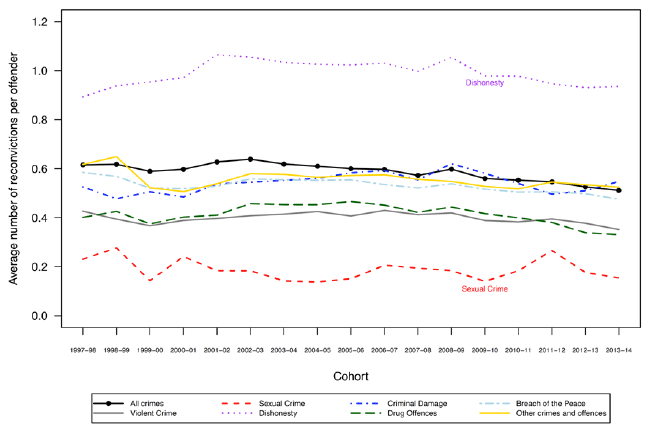
1.4 Index disposal
( Table 8 )
A disposal is the sentence given for a court conviction (i.e. custodial or community sentence), or the action taken in non-court cases (i.e. Anti-social Behaviour Fixed Penalty Notices or Fiscal Fines). The index disposal is the sentence received for an index conviction (see Annex Table A1 and Annex A5 for definitions). If a person is convicted for more than one charge, then it is the disposal for the main crime/offence that is considered the index disposal (see Annex A4). A disposal may affect the reconviction rates, but different disposals are given for different types of offending behaviour, which are also likely to affect reconviction rates. There has been some evidence of a decline in the average number of reconvictions per offender across all types of disposals since 2004-05 ( Chart 6).
The rankings of the severity of disposals, and therefore the order they are presented in Table 8, have been changed from those in the previous bulletins to be in line with those used in the Criminal Proceedings in Scotland statistical bulletin. From this bulletin, the ranking of Restriction of Liberty Orders ( RLO) has been swapped with that of Community Payback Orders ( CPO), with the other disposals remaining in the same positions. This ranking is important because, if a person is convicted twice on the same day, the highest ranked, or most severe, disposal is used.
Drug Treatment and Testing Orders
Offenders given a Drug Treatment and Testing Order ( DTTO) have the highest average number of reconvictions per offender and the highest reconviction rate compared to the other disposals ( Table 8 and Chart 6). The number of offenders who received a DTTO in the 2013-14 cohort was 328. The average number of reconvictions per offender was 1.66 for this cohort which represents an increase of 5 per cent on the 2012-13 value of 1.58, and the reconviction rate was 62.8 per cent which is a 2.3 percentage point decrease on the 2012-13 value of 65.1.
Over time, there has been a decline in the average number of reconvictions per offender for offenders who are given a DTTO. In the past ten years, the average number of reconvictions per offender for DTTOs decreased by around half of an offence (0.54) per offender, on average, from 2.2 in 2004-05 to 1.66 in 2013-14. In the same period there has also been a decline in reconviction rates for those given DTTOs. The reconviction rate for 2013-14 was 62.8 per cent, which is 15.6 percentage points lower than the rate of 78.4 per cent in 2004-05.
The transition from Legacy Orders to Community Payback Orders
Community Payback Orders ( CPOs) were introduced by the Criminal Justice and Licensing (Scotland) Act 2010 and came into effect from 1 February 2011. The CPO replaces provisions for Community Service Orders ( CSO), Probation Orders ( PO) and Supervised Attendance Orders ( SAO) - the "legacy orders" - for any offences committed after this date. As a result, the legacy orders are now mainly being used in cases which have taken longer to progress from the offence being committed to sentencing in court. This may bias comparisons with other types of disposal. In line with previous bulletins, SAOs are still grouped under "other", due to the small numbers issued.
There has been a transition period between the phasing out of the legacy orders and the establishment of CPOs between 2010-11 up to the most recent cohort 2013-14, due to the different disposals being given for offences committed before or after the 1 st February 2011. The first cohort of offenders with an index disposal of a CPO in 2010-11 was therefore very small as they had to commit a crime and also be convicted between 1 February and 31 March 2011. As CPOs have become established, the number of offenders with an index disposal of a CPO increased from 174 in 2010-11 to 10,551 in 2013-14, whereas those with an index disposal of a legacy order decreased from 8,245 to 202 in the same period ( Table 8).
During the transition period from legacy orders to CPOs between 2010-11 and the most recent cohort of 2013-14, there were changes in the characteristics of offenders that were given these disposal types. Therefore caution is needed when comparing changes between the two disposal types during the transition period. Annex D details how three offender characteristics (number of previous convictions, gender and age) changed for CPOs and legacy orders during the transition period. Changes in offender characteristics are also likely to be responsible for the decreases in reconvictions of offenders given CPOs and legacy orders during the transition period, as both disposals showed an increase in the proportion of groups of offenders that typically have lower reconviction rates.
The 10,551 offenders with an index disposal of a CPO in 2013-14 had a reconviction rate of 30.4 per cent, which is 3.2 percentage points lower than the reconviction rate (33.6 per cent) of the legacy orders in 2009-10 before CPOs were introduced. The average number of reconvictions per offender for individuals given a CPO in 2013-14 was 0.55, 11 per cent lower than the figure of 0.62 for the legacy orders in 2009-10.
Custodial sentences
Those offenders released from a custodial sentence in the 2013-14 cohort had a higher reconviction rate and average number of reconvictions per offender than offenders given any other disposal except a DTTO. The reconviction rate for offenders released from custody in the 2013-14 cohort was 43.8 per cent, a 0.20 percentage point increase on the 2012-13 rate of 43.6 per cent. The average number of reconvictions per offender has decreased by 6 per cent since in the last year from 0.89 in 2012-13 to 0.84 in 2013-14 ( Table 8 and Chart 6).
Over the last decade, there has been a decline in the average number of reconvictions per offender for those released from custodial sentences, decreasing by nearly 21 per cent 1.06 in 2004-05 to 0.84 in 2013-14 ( Table 8, Chart 6). It may be interesting to note that the long term decline in the reconviction rate for custodial sentences has been set against a sustained overall increase in the prison population during the 00s. Since 2011-12, the prison population has been falling by about 2% a year. However, the relationship between patterns of reconviction and the prison population is not straightforward and one should not necessarily infer a direct causal link between the two. Trends in and drivers of the prison population are discussed in detail in the publication Prison statistics and population projections Scotland:2013-14.
Monetary disposals
There has been a continual decrease in the number of individuals who were given a monetary disposal since 2006-07. In 2006-07 there were 28,500 offenders with an index monetary disposal which has since nearly halved to 14,829 in 2013-14. This may in part reflect the impact of Summary Justice Reform which was designed to take less serious cases out of the court system (see Non-Court disposals). During this period, the average number of reconvictions for offenders with an index monetary disposal fell from 0.49 to 0.38, a decrease of 22 per cent.
Chart 6: Average number of reconvictions per offender by index disposal: 1997-98 to 2013-14 cohorts
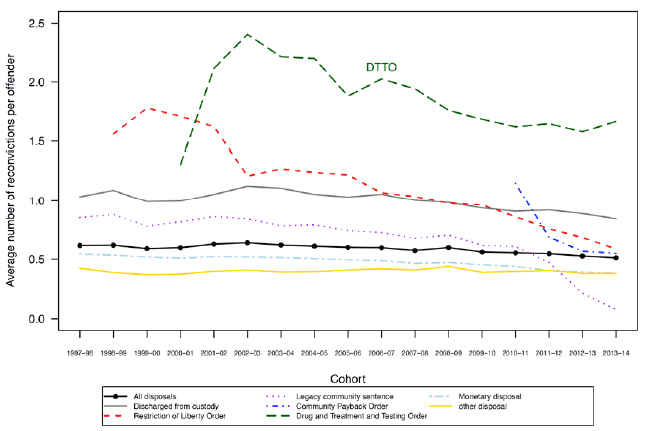
1.5 Sentence length of custodial index conviction
( Table 9 )
Offenders who were released from a custodial sentence of 3 months or less have a higher reconviction rate and average number of reconvictions per offender compared to those released from longer custodial sentences ( Table 9 and Chart 7). Offenders who commit relatively low level crimes but in high volumes are more likely to be reconvicted (see Section 1.3), and these offenders are more likely to get short custodial sentences. In contrast, longer custodial sentences are given to offenders that commit high level crimes, but these offenders tend to commit these crimes in low volumes, and hence are less likely to be reconvicted. For those released from short sentences of under 3 months, the average number of reconvictions per offender was 1.33, representing a 4 per cent decrease since 2012-13, and the reconviction rate was 61.1 per cent, a decrease of 0.50 percentage points since 2012-13. On the other hand, offenders released from sentences of over 4 years had an average number of reconvictions per offender of 0.12 and a reconviction rate of 10 per cent in 2013-14, both of which represent a general decline over the past ten years.
1.6 Conviction history prior to index conviction
( Table 10 )
Conviction history is a strong predictor for the likelihood of reconviction, as reconviction rates increase with increasing numbers of previous reconvictions. Offenders with more than 10 previous convictions in the past ten years have the highest reconviction rates, whereas offenders with no previous convictions in the past ten years have the lowest reconviction rates. This pattern holds true even when age, sex, or disposal (all of which have an association with the likelihood of reconviction) are taken into account ( Table 10 [4] )
Chart 7: Reconviction rates for index disposals and sentence lengths for the 2013-14 cohort 1
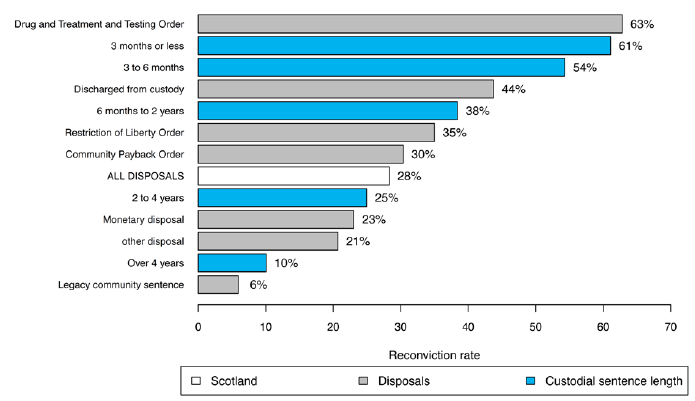
1. Chart 7 shows reconviction rates broken down by disposal type. This includes the category "disposal from custody" which shows reconviction rates for all offenders discharged from a custodial sentence in 2013-14, as well a further breakdown of this category by length of custodial sentence for comparison.
1.7 Two year rates
( Table 12 )
Historically, the reconviction rates in Scotland have been reported with a two year follow-up period. From the 2009-10 cohort bulletin onwards, the focus has been mainly on a follow-up period of one year rather than two years as, in general, the one year rate tracks the two year rate and has the benefit of being more timely.
Using the two year follow up period there has been a decline in the reconviction rate and in the average number of reconvictions per offender in the past 10 years ( Table 12). Since 2005-06 the average number of reconvictions per offender has fallen by 13 per cent from 1.13 to 0.98 in 2012-13 and the reconviction rate has shown a 4.3 percentage point reduction from 44.8 to 40.5 in 2012-13.
These declining trends mirror those seen for the one year follow up period ( Table 1) but as the number of reoffenders for the two year follow up period will also include those who reoffend over longer time periods, the associated values will typically be greater such as:
- In 2012-13 the two-year reconviction rate was 12.2 percentage points higher than the rate using a one year follow on period; and
- The average reconvictions per offender is around half an reconviction per offender (0.47) higher for the two year rate.
Contact
Email: Mark Bell
Phone: 0300 244 4000 – Central Enquiry Unit
The Scottish Government
St Andrew's House
Regent Road
Edinburgh
EH1 3DG
There is a problem
Thanks for your feedback